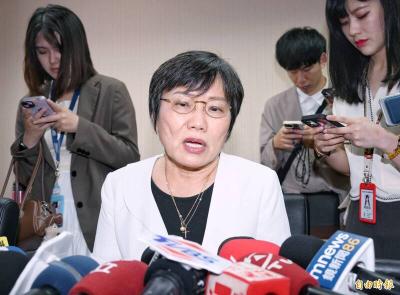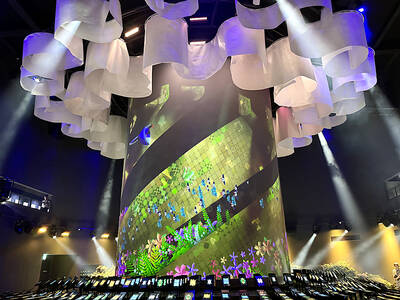The American Institute in Taiwan (AIT) yesterday announced that the installation of equipment to detect radiation at Kaohsiung Harbor had been completed, bringing Taiwan online as part of global efforts to combat the proliferation of weapons of mass destruction.
Under the auspices of the US Department of Energy’s National Nuclear Safety Administration (NNSA), the Second Line of Defense Megaports Initiative provides radiation detection equipment and training at major ports worldwide to strengthen the capability of the international community to detect and interdict trafficking in nuclear material through maritime shipping.
Better known by its shorter name, the Megaports Initiative equips ports with radiation portal monitors for the detection of radiation, handheld devices to identify radioactive isotope, optical character recognition technology to identify containers, communications equipment to send data to a central alarm station, as well as training and technical support.
The Megaports Initiative, which brings in customs, law enforcement, port authorities, terminal operators and other government agencies, is now operational in 34 ports worldwide, with work under way at 18 other ports in Asia, Latin America and the Caribbean, Europe, the Middle East and Africa. The Megaports Initiative seeks to equip 100 seaports with radiation detection systems by 2016, scanning about 50 percent of global maritime containerized cargo and more than 80 percent of US-bound container traffic.
KEY LINK
The AIT and the Taipei Economic and Cultural Representative Office signed a memorandum of understanding to implement the Megaports Initiative in Taiwan in 2006. Because of its strategic location, high volume and role as a key transshipment port in the Asian region, the inclusion of Kaohsiung Harbor in the initiative was seen as key to strengthening interdiction in the region.
Work to equip Kaohsiung Harbor began in 2007, with the installation of radiation detection equipment and training of Taiwanese officials. Because of the size of Kaohsiung Harbor, work was divided into two phases, with phase 1 involving the installation of detection equipment at terminals 2, 3 and 5, and phase 2 the completion of terminals 1 and 4, AIT said.
Kaohsiung Customs launched Megaports Initiative operations in November 2009 at all phase 1 sites, with all phase 2 sites coming online in October last year.
According to the NNSA, more than 90 percent of global commerce is transported through the maritime shipping network via cargo containers, with about 500 million twenty-foot-equivalent units — a measure of volume in the transport of containers — transiting the globe annually.
ROGUE STATES
Because of its technological base and strategic location for direct shipment or transshipment, Taiwan has become the focus of rogue states such as Iran and North Korea and non-state organizations seeking to acquire material that could be used in the production of nuclear weapons.
In August 2003, the North Korean cargo vessel Be Gaehung was detained at Kaohsiung Harbor after US intelligence notified Taiwanese authorities that the vessel was suspected of carrying chemicals associated with rocket fuel.
Reports in December 2009 showed that Iran sought to obtain hundreds of pressure transducers, which can be used to enrich uranium to weapons grade, from Heli-Ocean Technology Co, a Taiwanese agent, via a company based in Shanghai.
AIT, the US Department of Energy, the Ministry of Finance and the Directorate General of Customs will celebrate the completion of the project at a ceremony on Friday at the US Commerce and Culture Activity Center in Greater Kaohsiung, AIT said.

Chinese Nationalist Party (KMT) Chairman Eric Chu (朱立倫), spokeswoman Yang Chih-yu (楊智伃) and Legislator Hsieh Lung-chieh (謝龍介) would be summoned by police for questioning for leading an illegal assembly on Thursday evening last week, Minister of the Interior Liu Shyh-fang (劉世芳) said today. The three KMT officials led an assembly outside the Taipei City Prosecutors’ Office, a restricted area where public assembly is not allowed, protesting the questioning of several KMT staff and searches of KMT headquarters and offices in a recall petition forgery case. Chu, Yang and Hsieh are all suspected of contravening the Assembly and Parade Act (集會遊行法) by holding

PRAISE: Japanese visitor Takashi Kubota said the Taiwanese temple architecture images showcased in the AI Art Gallery were the most impressive displays he saw Taiwan does not have an official pavilion at the World Expo in Osaka, Japan, because of its diplomatic predicament, but the government-backed Tech World pavilion is drawing interest with its unique recreations of works by Taiwanese artists. The pavilion features an artificial intelligence (AI)-based art gallery showcasing works of famous Taiwanese artists from the Japanese colonial period using innovative technologies. Among its main simulated displays are Eastern gouache paintings by Chen Chin (陳進), Lin Yu-shan (林玉山) and Kuo Hsueh-hu (郭雪湖), who were the three young Taiwanese painters selected for the East Asian Painting exhibition in 1927. Gouache is a water-based

Taiwan would welcome the return of Honduras as a diplomatic ally if its next president decides to make such a move, Minister of Foreign Affairs Lin Chia-lung (林佳龍) said yesterday. “Of course, we would welcome Honduras if they want to restore diplomatic ties with Taiwan after their elections,” Lin said at a meeting of the legislature’s Foreign Affairs and National Defense Committee, when asked to comment on statements made by two of the three Honduran presidential candidates during the presidential campaign in the Central American country. Taiwan is paying close attention to the region as a whole in the wake of a

OFF-TARGET: More than 30,000 participants were expected to take part in the Games next month, but only 6,550 foreign and 19,400 Taiwanese athletes have registered Taipei city councilors yesterday blasted the organizers of next month’s World Masters Games over sudden timetable and venue changes, which they said have caused thousands of participants to back out of the international sporting event, among other organizational issues. They also cited visa delays and political interference by China as reasons many foreign athletes are requesting refunds for the event, to be held from May 17 to 30. Jointly organized by the Taipei and New Taipei City governments, the games have been rocked by numerous controversies since preparations began in 2020. Taipei City Councilor Lin Yen-feng (林延鳳) said yesterday that new measures by